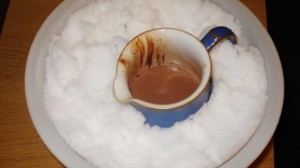The first English recipes for iced chocolate desserts have been uncovered by academics.
Dr Kate Loveman, from University of Leicester, found the recipes cited in the manuscripts of the Earl of Sandwich in 1668 – one hundred years before his great-great-grandson allegedly invented the sandwich.
The earl’s recipe for an iced chocolate treat reads: “Prepare the chocolatti (to make a drink) … and Then Putt the vessell that hath the Chocolatti in it, into a Jaraffa [carafe] of snow stirred together with some salt, & shaike the snow together sometyme & it will putt the Chocolatti into tender Curdled Ice & soe eate it with spoons.”
Dr Loveman, from the university’s school of English, said: “It’s not chocolate ice-cream but more like a very solid and very dark version of the iced chocolate drinks you get in coffee shops today. Freezing food required cutting-edge technology in 17th-century England, so these ices were seen as great luxuries.”
Chocolate treats even came with a health warning back in the 1600s.
“Chocolate was first advertised in England around 1640 as an exotic drink made from cacao beans. In the 1660s, when the Earl of Sandwich collected his recipes, chocolate often came with advice about safe consumption,” Dr Loveman said.
“One physician cautioned that the ingredients in hot chocolate could cause insomnia, excess mucus, or haemorrhoids. People worried that iced chocolate in particular was ‘unwholesome’ and could damage the stomach, heart, and lungs.”
The earl believed the best way to ward off the dangers of eating frozen chocolate was to drink hot chocolate “1/4 of an houre after”.
Dr Loveman’s research also shows some of the continuities in chocolate advertising across the centuries, as well as sharp differences.
“Today’s chocolate promoters, like some in the 17th century, often find cause to highlight women, pleasure and sexuality. In the 17th century, however, the fact that frequent chocolate consumption might make you ‘fat and corpulent’ was an attraction, something advertisers now prefer to keep quiet about.”





